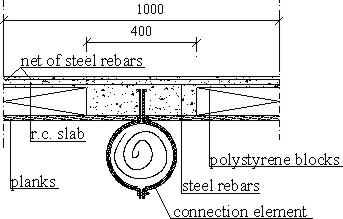
engineering & technology publications
ISSN 1759-3433
PROCEEDINGS OF THE EIGHTH INTERNATIONAL CONFERENCE ON COMPUTATIONAL STRUCTURES TECHNOLOGY
Numerical Analysis of Innovative Steel Connections for a Composite Wood-Steel-Concrete Floor
Department of Structural Analysis and Design, University of Naples "Federico II", Italy
Refined numerical models have been developed by means of the non-linear code for structural calculation ABAQUS [3], aiming at evaluating the structural performance of the new connection systems. Firstly, as a preliminary and indispensable phase, the material model calibration has been performed on the basis of the results of laboratory tests [4,5,6,7]. In the subsequent phase of the work the push-out numerical analysis of the proposed system, with reference to both rectangular and circular cross-sections of the wooden beam, has been performed.
Different configurations of the base system have been examined. In particular with reference to the rectangular shape two, three and four parts of the sleeve, bolted together at the sleeve wings, have been considered; with reference to the circular shape a two parts sleeve has been analysed, considering both different thicknesses and bolt tightening.
Results of the analyses have shown that on one hand the increase of the number of sleeves allows a significant improvement of the system performance in terms of both strength and stiffness. Nevertheless, the complexity of the intervention becomes more evident, due to both greater use of materials and the installation processes. On the other hand the increase in the sleeve thickness does not provide an important improvement in the system behaviour in terms of strength, but only a slight increase of stiffness, due to the enlargement of the wooden-rubber contact surface; whereas, a greater bolt tightening gives rise to a better behaviour of the system in terms of strength. It is worth noticing that the theoretical strength is never attained, because the actual contact surfaces are always smaller than the one corresponding to the full contact (as in the theoretical case).
Finally, a very simple relationship between the surface contact variation and the stiffness variation of the system has been set up, which is very useful for the system design.
- 1
- G. Turrini, M. Piazza, "The static behaviour of the composed wooden-concrete structures" (in Italian). Recuperare, n. 6, 1983.
- 2
- P. Gelfi, E. Giurani, A. Marini, "Behaviour of stud shear connectors in the composed wooden-concrete beams: theoretical modelling and experimental comparison" (in Italian). Proc. of the 3rd Italian Workshop on the Composed Structures, Ancona, 29-30 October 1998.
- 3
- Hibbitt, Karlsson, Sorensen, Inc. 2004, "ABAQUS/Standard, v. 6.4", Patwtucket, USA.
- 4
- B. Calderoni, G. De Matteis, F. M. Mazzolani, "Structural performance of ancient wooden beams: experimental analysis, European timber buildings as an expression of technological and technical cultures", Editions Scientifique et Medicales, Elsevier S.A.S., pg. 217-233, 2002.
- 5
- F. Ramundo, "Mechanical characterization of ancient structural timber" (in Italian), PhD Thesis, Second University of Naples, 2004.
- 6
- F.M. Mazzolani, B. Calderoni, G. De Matteis, C. Giubileo, "Experimental analysis of ancient wooden beams for flexural and shear failure", Proc. of the 4th International Seminar "Structural analysis of historical constructions", Padova, Italy, November 10-13, 2004.
- 7
- M. Forni, A. Martelli, G. Vernoni, A. Marioni, F. Bettinali, "Most Recent Experimental and Numerical Studies performed in Italy on Seismic Isolation", Proc. of the 12th Int. Conf. on Structural Mechanics in Reactor Technology, Stutthgart, Germany, 15-20 August, 1993.
purchase the full-text of this paper (price £20)
go to the previous paper
go to the next paper
return to the table of contents
return to the book description
purchase this book (price £140 +P&P)
